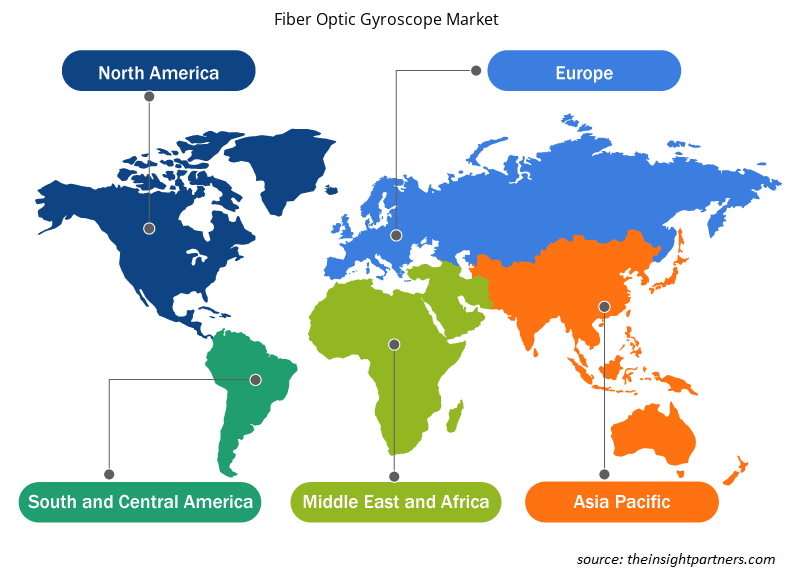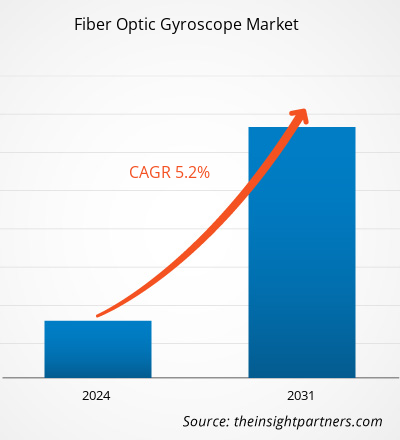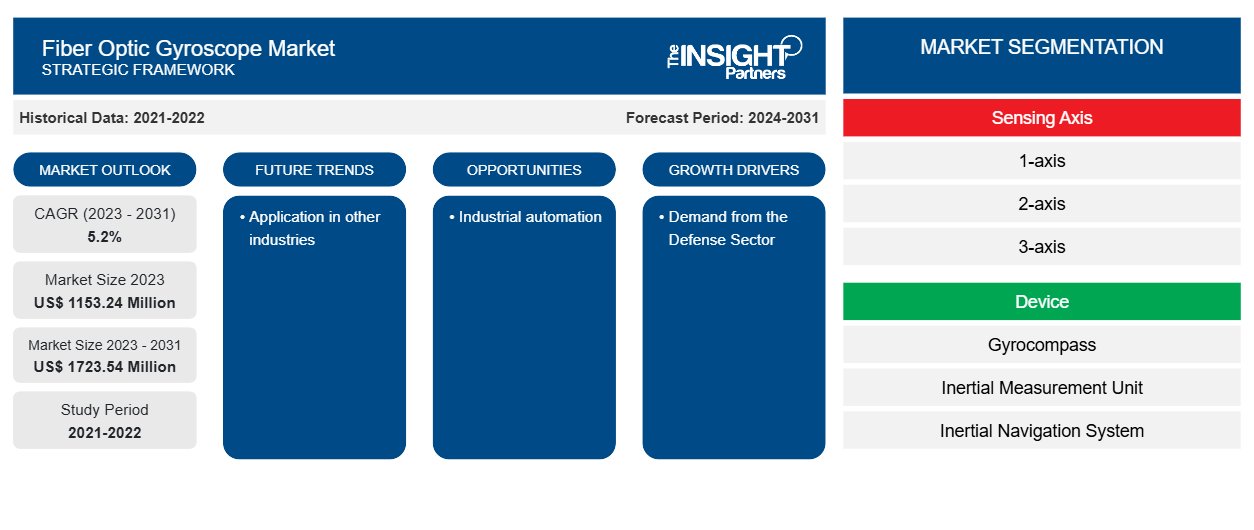Si prevede che la dimensione del mercato dei giroscopi in fibra ottica raggiungerà 1723,54 milioni di dollari entro il 2031, rispetto ai 1153,24 milioni di dollari del 2023. Si prevede che il mercato registrerà un CAGR del 5,2% nel 2023-2031. L'aumento della spesa militare e i vantaggi offerti dai giroscopi in fibra ottica rimarranno probabilmente tendenze chiave del mercato dei giroscopi in fibra ottica.
Analisi di mercato del giroscopio in fibra ottica
Grazie ai numerosi vantaggi dei giroscopi in fibra ottica, come le dimensioni ridotte, la leggerezza, il basso consumo energetico, la lunga durata, l'elevata affidabilità e la produzione di massa, vari settori come l'aerospaziale e la difesa, i settori industriali e altri richiedono giroscopi in fibra ottica. Pertanto, le sue richieste da vari settori favoriscono la crescita del suo mercato. Inoltre, la crescita della spesa militare in tutto il mondo dovuta all'attenzione del governo sul rafforzamento del suo settore militare alimenta la domanda di giroscopi in fibra ottica nelle applicazioni di guida dei veicoli azionati a distanza.
Panoramica del mercato dei giroscopi in fibra ottica
Un giroscopio in fibra ottica viene utilizzato per misurare la velocità angolare, che viene utilizzata in varie applicazioni che vanno dalla navigazione missilistica al controllo del movimento. I giroscopi in fibra ottica presentano diversi vantaggi rispetto ad altri tipi di giroscopi, tra cui leggerezza, dimensioni ridotte, lunga durata, basso consumo energetico, elevata affidabilità e produzione di massa. Per la navigazione, la guida e il controllo di missili, aerei, robot, automobili, veicoli spaziali, ecc., è uno strumento particolarmente importante.
Personalizza questo report in base alle tue esigenze
Riceverai la personalizzazione gratuita di qualsiasi report, comprese parti di questo report, o analisi a livello nazionale, pacchetto dati Excel, oltre a usufruire di grandi offerte e sconti per start-up e università
-
Scopri le principali tendenze di mercato in questo rapporto.Questo campione GRATUITO includerà analisi di dati che spaziano dalle tendenze di mercato alle stime e alle previsioni.
Driver e opportunità del mercato dei giroscopi in fibra ottica
Domanda del settore della difesa da parte degli operatori di mercato per favorire il mercato
Diversi vantaggi dei giroscopi in fibra ottica, che includono un'elevata velocità di rotazione e un'elevata risoluzione rispetto ai loro sostituti, come alternative come giroscopi meccanici e giroscopi laser ad anello, ne alimentano l'adozione nel settore della difesa. Grazie ai suoi vantaggi, gli operatori del mercato ricevono ordini che promuovono il mercato dei giroscopi in fibra ottica. Ad esempio, nell'agosto 2021, KVH Industries, Inc. (Nasdaq: KVHI), ha annunciato di aver ricevuto un ordine di giroscopi in fibra ottica (FOG) da 7,9 milioni di dollari da Escribano, un appaltatore della difesa spagnolo, per la sua nuova torretta a controllo remoto Guardian 30.
Applicazione in altri settori: un’opportunità nel mercato dei giroscopi in fibra ottica
I giroscopi in fibra ottica sono stati originariamente sviluppati per applicazioni militari e di difesa; tuttavia, grazie ai loro potenziali vantaggi rispetto agli altri tipi di giroscopi, sono ampiamente adottati anche in altri settori, tra cui i settori commerciale e industriale in tutto il mondo. C'è una rapida domanda di giroscopi in fibra ottica anche nei settori automobilistico, medico e robotico. La crescente domanda di soluzioni tecnologicamente avanzate per migliorare l'efficienza operativa in diversi settori e la crescente tendenza all'automazione industriale stanno ulteriormente spingendo la domanda di giroscopi in fibra ottica.
Analisi della segmentazione del rapporto di mercato del giroscopio in fibra ottica
I segmenti chiave che hanno contribuito alla derivazione dell'analisi di mercato dei giroscopi in fibra ottica sono l'asse di rilevamento, il dispositivo e l'applicazione.
- In base all'asse di rilevamento, il mercato è segmentato in 1 asse, 2 assi e 3 assi. Il segmento a 3 assi ha detenuto una quota di mercato maggiore nel 2023.
- Per dispositivo, il mercato è segmentato in girobussola, unità di misura inerziale, sistema di navigazione inerziale e sistema di riferimento di rotta di assetto. Il segmento delle unità di misura inerziale ha detenuto la quota maggiore del mercato nel 2023.
- Per applicazione, il mercato è segmentato in applicazioni di livello tattico, guida di veicoli azionati a distanza, aeronautica e aviazione, robotica e difesa e sicurezza interna. Il segmento difesa e sicurezza interna ha detenuto la quota maggiore del mercato nel 2023.
Analisi della quota di mercato del giroscopio in fibra ottica per area geografica
L'ambito geografico del rapporto sul mercato dei giroscopi in fibra ottica è suddiviso principalmente in cinque regioni: Nord America, Asia Pacifico, Europa, Medio Oriente e Africa e Sud America/Sud e Centro America.
In termini di fatturato, il Nord America ha rappresentato la quota di mercato più grande del giroscopio in fibra ottica nel 2023. Si prevede che la regione Asia-Pacifico crescerà con il CAGR più elevato durante il periodo di previsione.
La continua richiesta di nuove tecnologie per operazioni di combattimento e non da parte delle forze di difesa sta incrementando la spesa per la difesa in Nord America. Secondo lo Stockholm International Peace Research Institute (SIPRI), gli Stati Uniti, il più grande spenditore militare al mondo, hanno raggiunto gli 877 miliardi di dollari nel 2022, ovvero il 39 percento della spesa militare globale totale e tre volte di più rispetto alla cifra spesa dalla Cina, il secondo più grande spenditore al mondo. Tale spesa militare porta alla domanda di tecnologia avanzata per sistemi di navigazione affidabili e precisi in aeromobili e missili, che richiedono ulteriormente giroscopi in fibra ottica poiché offrono una migliore precisione.
Approfondimenti regionali sul mercato dei giroscopi in fibra ottica
Le tendenze regionali e i fattori che influenzano il mercato dei giroscopi in fibra ottica durante il periodo di previsione sono stati ampiamente spiegati dagli analisti di Insight Partners. Questa sezione discute anche i segmenti e la geografia del mercato dei giroscopi in fibra ottica in Nord America, Europa, Asia Pacifico, Medio Oriente e Africa e America meridionale e centrale.

- Ottieni i dati specifici regionali per il mercato dei giroscopi in fibra ottica
Ambito del rapporto di mercato del giroscopio in fibra ottica
| Attributo del report | Dettagli |
|---|---|
| Dimensioni del mercato nel 2023 | 1153,24 milioni di dollari USA |
| Dimensioni del mercato entro il 2031 | 1723,54 milioni di dollari USA |
| CAGR globale (2023-2031) | 5,2% |
| Dati storici | 2021-2022 |
| Periodo di previsione | 2024-2031 |
| Segmenti coperti |
Per asse di rilevamento
|
| Regioni e Paesi coperti |
America del Nord
|
| Leader di mercato e profili aziendali chiave |
|
Densità dei giocatori del mercato del giroscopio in fibra ottica: comprendere il suo impatto sulle dinamiche aziendali
Il mercato del giroscopio in fibra ottica sta crescendo rapidamente, spinto dalla crescente domanda degli utenti finali dovuta a fattori quali l'evoluzione delle preferenze dei consumatori, i progressi tecnologici e una maggiore consapevolezza dei vantaggi del prodotto. Con l'aumento della domanda, le aziende stanno ampliando le loro offerte, innovando per soddisfare le esigenze dei consumatori e capitalizzando sulle tendenze emergenti, il che alimenta ulteriormente la crescita del mercato.
La densità degli operatori di mercato si riferisce alla distribuzione di aziende o società che operano in un particolare mercato o settore. Indica quanti concorrenti (operatori di mercato) sono presenti in un dato spazio di mercato in relazione alle sue dimensioni o al valore di mercato totale.
Le principali aziende che operano nel mercato dei giroscopi in fibra ottica sono:
- Navigazione avanzata
- Cielo Inertial Solutions Ltd.
- iXblu
- Società per azioni Emcore
- Fizoptica
- Honeywell International Inc
Disclaimer : le aziende elencate sopra non sono classificate secondo un ordine particolare.

- Ottieni una panoramica dei principali attori del mercato dei giroscopi in fibra ottica
Notizie e sviluppi recenti sul mercato dei giroscopi in fibra ottica
Il mercato dei giroscopi in fibra ottica viene valutato raccogliendo dati qualitativi e quantitativi dopo la ricerca primaria e secondaria, che include importanti pubblicazioni aziendali, dati associativi e database. Di seguito è riportato un elenco degli sviluppi nel mercato:
- A gennaio 2024, Advanced Navigation ha annunciato la sua nuova gamma di sistemi di navigazione inerziale giroscopica in fibra ottica (INS), Boreas. Boreas è un INS di livello strategico ad altissima precisione, che offre una riduzione del 40% in termini di dimensioni, peso, potenza e costi rispetto ai sistemi concorrenti. Boreas è il primo prodotto a essere rilasciato basato sulla nuova tecnologia DFOG (Digital Fibre Optic Gyroscope) di Advanced Navigation, che è il culmine di 25 anni di sviluppo che hanno coinvolto due istituti di ricerca. Boreas è mirato ad applicazioni che richiedono orientamento e navigazione sempre disponibili e ad altissima precisione, tra cui marina, rilevamento, sottomarino, aerospaziale, robotica e spazio. (Fonte: Advanced Navigation, comunicato stampa, 2024)
- A settembre 2021, i team di iXblue hanno annunciato il lancio della serie UmiX. Questa gamma all'avanguardia di unità di misura inerziali (IMU) era basata sulla tecnologia del giroscopio a fibra ottica (FOG). (Fonte: iXblue, comunicato stampa, 2021)
Copertura e risultati del rapporto sul mercato del giroscopio in fibra ottica
Il rapporto "Dimensioni e previsioni del mercato del giroscopio in fibra ottica (2021-2031)" fornisce un'analisi dettagliata del mercato che copre le seguenti aree:
- Dimensioni del mercato e previsioni a livello globale, regionale e nazionale per tutti i segmenti di mercato chiave coperti dall'ambito
- Dinamiche di mercato come fattori trainanti, vincoli e opportunità chiave
- Principali tendenze future
- Analisi dettagliata delle cinque forze PEST/Porter e SWOT
- Analisi di mercato globale e regionale che copre le principali tendenze di mercato, i principali attori, le normative e gli sviluppi recenti del mercato
- Analisi del panorama industriale e della concorrenza che copre la concentrazione del mercato, l'analisi della mappa di calore, i principali attori e gli sviluppi recenti
- Profili aziendali dettagliati
- Analisi storica (2 anni), anno base, previsione (7 anni) con CAGR
- Analisi PEST e SWOT
- Valore/volume delle dimensioni del mercato - Globale, Regionale, Nazionale
- Industria e panorama competitivo
- Set di dati Excel
Report recenti
Rapporti correlati
Testimonianze
Motivo dell'acquisto
- Processo decisionale informato
- Comprensione delle dinamiche di mercato
- Analisi competitiva
- Analisi dei clienti
- Previsioni di mercato
- Mitigazione del rischio
- Pianificazione strategica
- Giustificazione degli investimenti
- Identificazione dei mercati emergenti
- Miglioramento delle strategie di marketing
- Aumento dell'efficienza operativa
- Allineamento alle tendenze normative























 Ottieni un campione gratuito per - Mercato dei giroscopi in fibra ottica
Ottieni un campione gratuito per - Mercato dei giroscopi in fibra ottica